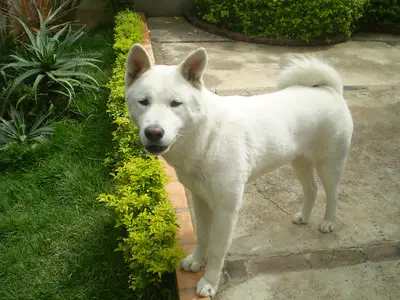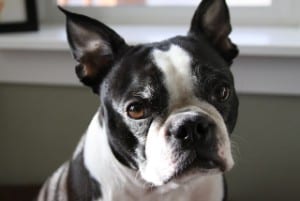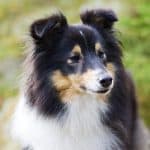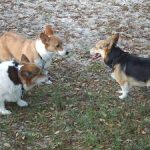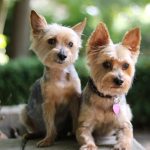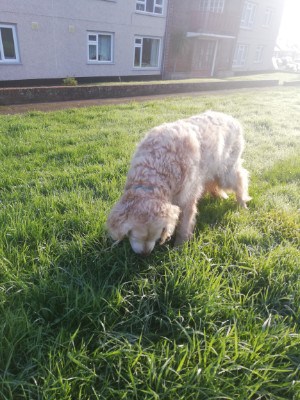
The latest in my list of dog breeds contains dogs that have wavy hair on their backs.
Dogs with wavy hair on their backs tend to have straight hair or flat coats.
And not every dog within the breed will necessarily have a wavy coat along their back.
And the first breed on this list are Golden Retrievers.
These are a breed that I know very well as I have two of them.
And both of them have wavy hair on their backs.
And you can see my oldest, in the photo on the right, with a beautiful wave along her back!
[1] Golden Retriever
Golden Retrievers are adorable pups that come in all shades of gold (cliché, I know). These silky smooth gundogs were bred to retrieve waterfowl during hunting parties. That’s why they have such soft mouths. You know, so they won’t damage whatever was shot. They also have wavy hair. Goldens are natural athletes and incredibly easy to train, making them perfect family dogs. That, and the fact that they’re super social.
Golden Retrievers have a long lifespan compared to other dogs (up to 14 years) – another reason to have them as part of your family.
[2] Chesapeake Bay Retriever
The Chesapeake Bay Retriever is a large gundog with a wavy, waterproof coat ranging from light to dark brown. This slightly oily double coat was intended to protect Chessies from the freezing Chesapeake Bay estuary, where they hunted ducks with their human parents. An added benefit for this powerful swimmer is his webbed feet.
These affectionate pups make excellent family dogs since they’re super protective of their “pack.” Being highly intelligent and energetic, Chessies need a job to keep them out of mischief. Since Chessies are sensitive souls, they also make excellent therapy dogs. All-rounders, right?
[3] Labrador Retriever
Labs are prom queen-level popular all around the world. Their dense, silky coats come in many colors, including black, chocolate, and all shades of yellow. They generally have straight hair, but you can find the odd exception with wavy hair. Bred for retrieving fish and fowl in icy weather, Labs are incredibly resistant to cold weather. They also have an “otter tail” to help them navigate rough river currents.
Interestingly, Labradors don’t hail from Labrador, but from Newfoundland. These highly intelligent dogs are excellent guides and rescue dogs since they’re gentle and eager to please. Brimming with energy, this indefatigable working dog requires tons of exercise daily.
[4] Flat-Coated Retriever
This cheerful, black or liver-colored retriever hailed from England and was initially bred to serve as gundog working both on land and in the water. The name is a bit of a misnomer, since their coats are generally wavy. Known as the kids of the canine world, these pups hardly ever grow up. Seriously, they’re like teenagers who never grow up, goofing off well into old age. That’s why the Flat-Coated Retriever needs a ton of exercise to keep them out of mischief.
Luckily, the intelligent Flat Coats are easy to train since they’re eager to please. These are gentle dogs, though, so they don’t respond well to harsh training methods.
[5] German Longhaired Pointer
This versatile gundog comes in all colors except black. Seriously. It’s one of the only gundog breeds that doesn’t allow for black in the breed standard. They’re gorgeous, though, with a dense, wavy coat ranging from rich chocolate to dappled white and brown.
German Longhaired Pointers have the unique ability to be both calm family dogs and fiery hunters, depending on the situation. Being an old European breed, these pups were used by falconers before rifle hunting became a thing. They even trace their lineage back to Bracken (Scenthounds). Versatile to the max!
[6] Longhaired Dachshund
Dachshunds can have three types of coats: smooth, wirehaired, or longhaired. The gorgeous longhaired Dachshy has a whopping 12 recognized colors, including solid red or cream, and many two-tone combinations, like black and cream, chocolate and tan, and blue and cream. These coats tend to be wavy, making for an elegant appearance.
Bred as a cold-weather hunter, the Longhaired Dachshund will chase anything that moves. They’re independent and stubborn, so they’re often harder to train and require lots of exercise. That gorgeous coat also needs a ton of grooming, so be prepared to spend a lot of time with your cutesy little pup.
[7] Newfoundland
Newfoundlands are gentle giants bred as working dogs. Its flat, coarse coat comes in various colors, including gray, black, brown, and a black-and-white pattern called “Landseer” after the artist that popularised it. The Newfoundland’s coat is generally straight or slightly wavy.
These majestic pups are ideal “nanny dogs,” easy to train and amazing with kids. It’s a good thing they’re so gentle since they really are enormous and could easily outweigh their human parents.
Newfies were used as North Atlantic water rescue dogs, so they have partially webbed feet and are strong enough to rescue grown men from drowning. Wow!
[8] Belgian Sheepdog
The Belgian Sheepdog is either one breed made up of four varieties, or four distinct breeds, depending on where you’re from. Confused? In the States, we see them as the Groenendal (longhaired black), Laekenois (rough-haired fawn), Malinois (short-haired fawn), and Tervuren (longhaired fawn). Europeans, on the other hand, view them all as one breed. Their coats are generally thick and straight, but you can find some with wavy hair on the crest or around the ears.
Either way, these serious herding dogs are built for work – they even served as messengers, ambulance dogs, and freighters during World War I. They require tons of daily exercise, always with their human parent. These loyal pups hate being alone and won’t do much without companionship.
[9] English Setter
English Setters have gorgeously silky, medium-length speckled coats with wavy fringes around the ears, tails, and bellies. This strikingly unique appearance even has its own name – Belton – and comes in various colors, including liver, lemon, and orange. These mellow gentlemen socialize equally well with humans and other dogs and are super easy to get along with.
Bred for hunting, these dogs lie down when they spot a flock of birds or whatever else you’re hunting. That allows the hunter to cast a net over the birds without getting the dog all caught up in it. Smart pups!
[10] Great Pyrenees
These giant herding dogs are fiercely protective of their herds (both human and animal) and were bred to deter wolves and other predators in snowy European mountains. Their thick, white coats are waterproof and tangle- and dirt-resistant. Still needs a ton of grooming, though. These luxurious coats are either straight or slightly wavy. Never curly, though.
Traditionally, Pyrs used to conserve their energy and tremendous strength for when a threat occurs, so they don’t need tons of exercise. Despite their size, they make excellent indoor family companions.
As patient, independent thinkers, Pyrs don’t like obedience training much. They just don’t see the point!
[11] Borzoi
These Russian hunting dogs are the epitome of grace and regal elegance, all while running at a remarkable 35 – 40 miles per hour. Their long, luscious coats come in various colors, including black, white, brindle, fawn, cream, and red. These flat coats tend to be wavy or slightly curly.
Despite their calm, easygoing temperaments, Borzoi are born hunters, so they’ll chase anything that moves. For this reason, your pup should always be on a leash or in a securely enclosed area. They’re not as boisterous as other hunting dogs, though, so they make ideal house pets.
[12] Bernese Mountain Dogs
The Romans brought these good-natured giants to Switzerland around 2000 years ago to serve as working dogs on Alpine farms. The Ber’s thick, wavy coat is tricolored: black, white, and rust.
While Bernese Mountain Dogs are robust, versatile working dogs, they’re super gentle, especially with children. These pups usually choose one lucky human as their “person,” remaining politely aloof to the rest of humanity.
Sensitive souls that they are, Bers don’t respond well to harsh training methods. Still, they’re incredibly intelligent and easy to train if you do it with lots of love and gentleness.

